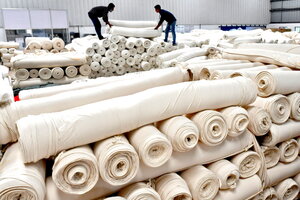Time to clean out the wardrobe?
The world’s highly polluting fashion industry faces a regulatory bill in New York that might help consumers rethink their relationship to the clothes they buy.

Workers stack cotton fabric rolls at a textile factory in Andhra Pradesh, India.
Reuters
Propelled by the rapid pace of today’s fashion industry to introduce new styles – known as fast fashion – it’s no wonder many clothes buyers find themselves with a “closet of regrets,” as The Wall Street Journal dubs it. All the clothes that don’t get worn can hang heavy on a consumer’s mind until they are finally thrown away. The trouble is, “There’s no ‘away’ for your clothes,” says Maxine Bédat, author of a 2021 book, “Unraveled: The Life and Death of a Garment,” and an activist trying to alter the industry’s wasteful ways.
A few stats tell the story. Every second, worldwide, the equivalent of a garbage truck of textiles is dumped in landfills or burned in incinerators. The plastic that makes up 60% of clothes ends up as microplastics in seas, soil, air, even arctic ice. The industry produces 10% of all carbon emissions and a fifth of industrial water pollution worldwide.
Although some companies have voluntarily tried to minimize their environmental and social impact, little progress has been made. So, this January a bill was introduced in New York state’s legislature that would set high standards for the industry while helping consumers better understand the impact of their purchases. The bill is aimed at the recognized fashion capital of the world: New York City.
Known as the New York Fashion Act, the proposed law would require every large multinational fashion name operating in the state – from luxury brands to fast-fashion giants – to map their global supply chains, disclose their environmental and social impacts, and set Science-Based Targets to cut emissions. Failure to meet the targets could bring a 2% penalty on annual revenue
Ms. Bédat, who worked with the bill’s co-sponsors to craft the measure, says the industry’s pell-mell growth in the 1990s led to a race for ever cheaper costs. That led to supply chains so dispersed and tangled that clothing brands themselves were in the dark. Calls for voluntary standards and corporate responsibility only led many companies on a detour of “greenwashing” – using often-dubious claims of “sustainability” as a marketing tool.
The bill is pro-business, contends Ms. Bédat, because it would level the playing field for companies to operate at the same environmental standards. It “is an effort to meet industry [leaders] where they are, recognize the good faith efforts they are already making, and come up with a common standard, but do so with some teeth,” she told The New York Times.
Also involved in the bill’s creation was Ken Pucker, former chief operating officer of Timberland, a footwear company respected for its environmental leadership. “When you look back over the 20-25 years since corporate responsibility started, emissions are up 50%, says Mr. Pucker, now a senior lecturer at Tufts University’s Fletcher School. “So, something’s not working.”
“We have a system that values growth coupled with more people with more consumptive capacity coupled with cheaper stuff issued more frequently coupled with social media,” he says. When asked if a new consciousness of growth is needed, Mr. Pucker replies, “I’d say we need a new consciousness of success” – a broader vision of what and how we interpret value.
Similarly, Ms. Bédat is looking beyond the “more” of fashion to how people value their clothes. While researching her book, she followed the story of a garment from its beginning in cotton fields to oil rigs to textile mills, talking to the people whose work ends up in clothing. Afterward, she saw her own clothes differently. To really see them, she needed fewer of them. She learned to muzzle the barrage of marketing and social media influencers that drive the “more” of fashion.
“We need a richer relationship with our things,” she concludes. “And the value of them comes from the story behind our things as much as the things themselves. ... The message of my book is to really love your things,” she said in an RSA podcast.
Her book closes with a vision of a future when “we will love our [clothes] because we have wrested control of our own attention and removed the noise in our inboxes and on our social media channels that had distracted us from our true needs and desires. And we bought them not ... to fill other holes in our lives, but from an aware and informed mindset.” That could be just enough to clear out anyone’s “closet of regrets.”

